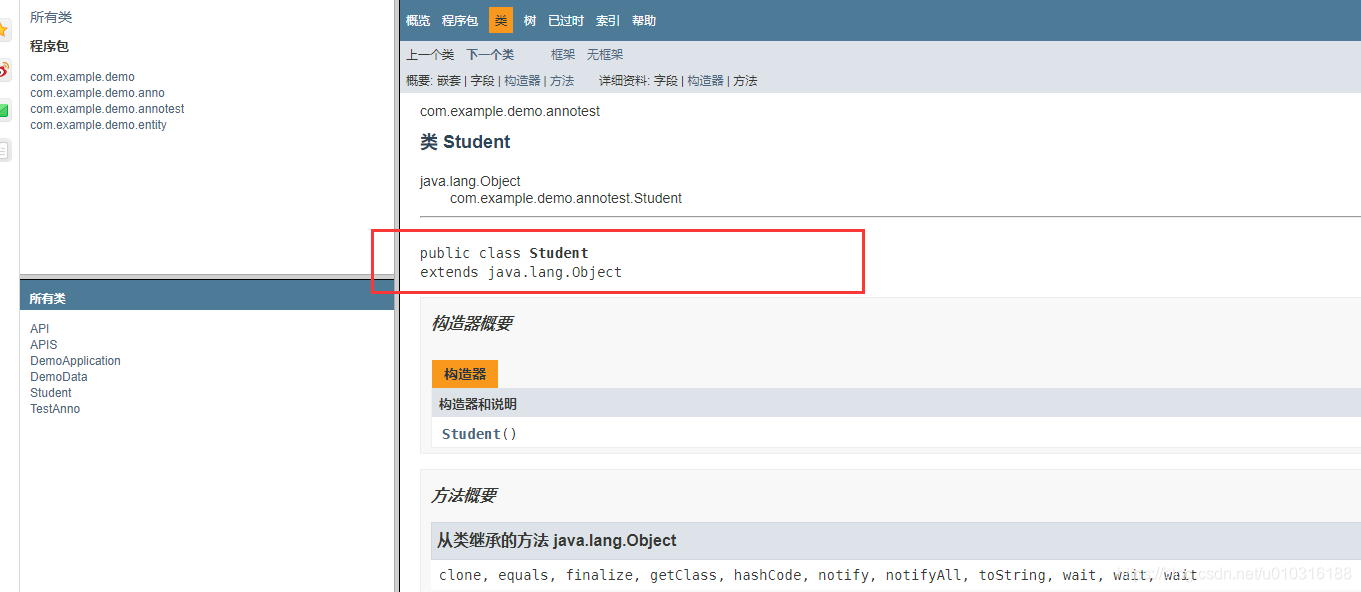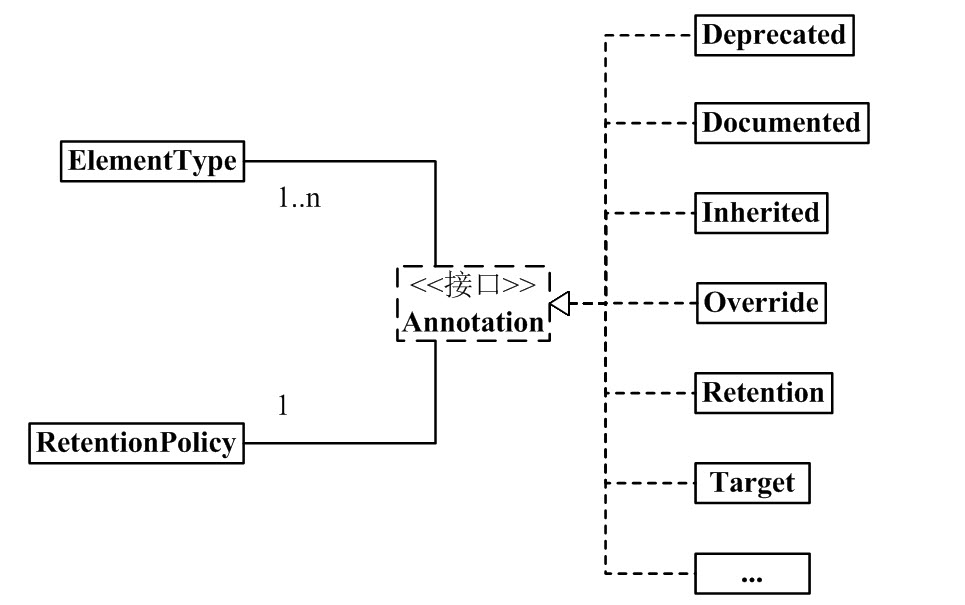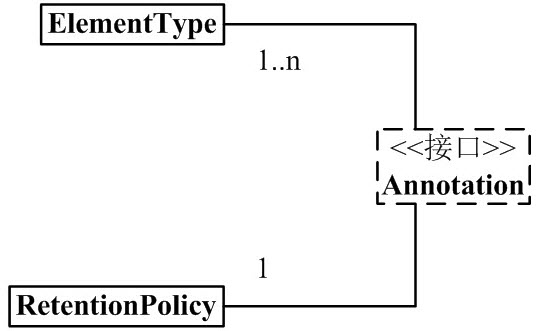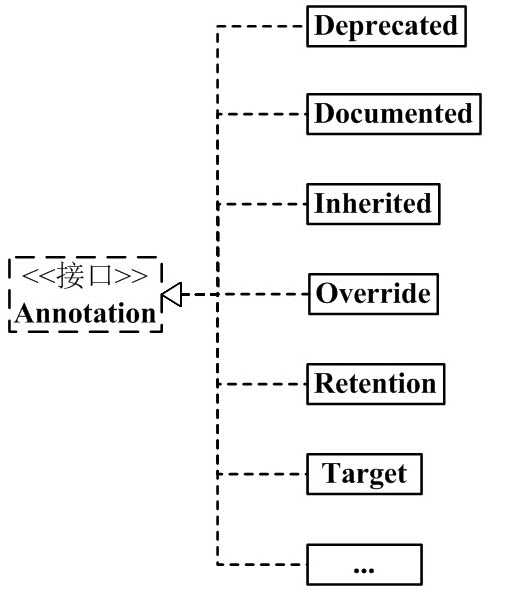元注解
@Target
java.lang.annotation.ElementType.TYPE://类、接口(包括注解类型)和枚举的声明 |
注意:如果一个注解没有指定@Target注解,则此注解可以用于除了TYPE_PARAMETER和TYPE_USE以外的任何地方。
以下我们看看ElementType.TYPE_PARAMETER和ElementType.TYPE_USE的使用示例,对于其他的ElementType注解元素,看其说明就知道怎么用了:
声明由ElementType.TYPE_PARAMETER标记的@NotEmpty注解:
package org.springmorning.demo.javabase.annotation.meta; |
声明由ElementType.TYPE_USE标记的@NotEmpty注解:
package org.springmorning.demo.javabase.annotation.meta; |
以下示例代码说明了这两种Target注解元素的使用区别,ElementType.TYPE_USE包含了ElementType.TYPE和ElementType.TYPE_PARAMETER
package org.springmorning.demo.javabase.annotation.meta; |
@Retention 注解的作用
注解@Retention可以用来修饰注解,是注解的注解,称为元注解。
Retention注解有一个属性value,是RetentionPolicy类型的,Enum RetentionPolicy是一个枚举类型,
这个枚举决定了Retention注解应该如何去保持,也可理解为Rentention 搭配 RetentionPolicy使用。
RetentionPolicy有3个值:CLASS RUNTIME SOURCE
按生命周期来划分可分为3类:
1、RetentionPolicy.SOURCE:注解只保留在源文件,当Java文件编译成class文件的时候,注解被遗弃;
2、RetentionPolicy.CLASS:注解被保留到class文件,但jvm加载class文件时候被遗弃,这是默认的生命周期;
3、RetentionPolicy.RUNTIME:注解不仅被保存到class文件中,jvm加载class文件之后,仍然存在;
这3个生命周期分别对应于:Java源文件(.java文件) —> .class文件 —> 内存中的字节码。
那怎么来选择合适的注解生命周期呢?
首先要明确生命周期长度 SOURCE < CLASS < RUNTIME ,所以前者能作用的地方后者一定也能作用。
一般如果需要在运行时去动态获取注解信息,那只能用 RUNTIME 注解,比如@Deprecated使用RUNTIME注解
如果要在编译时进行一些预处理操作,比如生成一些辅助代码(如 ButterKnife),就用 CLASS注解;
如果只是做一些检查性的操作,比如 @Override 和 @SuppressWarnings,使用SOURCE 注解。
注解@Override用在方法上,当我们想重写一个方法时,在方法上加@Override,当我们方法的名字出错时,编译器就会报错
注解@Deprecated,用来表示某个类或属性或方法已经过时,不想别人再用时,在属性和方法上用@Deprecated修饰
注解@SuppressWarnings用来压制程序中出来的警告,比如在没有用泛型或是方法已经过时的时候
**@**Documented
**@**Documented 注解表明这个注解应该被 javadoc工具记录. 默认情况下,javadoc是不包括注解的. 但如果声明注解时指定了 @Documented,则它会被 javadoc 之类的工具处理, 所以注解类型信息也会被包括在生成的文档中,是一个标记注解,没有成员。
带@Documented生成的javadoc

不带@Documented生成的javadoc
这两个图的唯一差距就是类的说明是否有这个@API注解。
总结
@Documented注解只是用来做标识,没什么实际作用,了解就好。
@SuppressWarnings
简介:
java.lang.SuppressWarnings是J2SE5.0中标准的Annotation之一。可以标注在类、字段、方法、参数、构造方法,以及局部变量上。**
作用:**告诉编译器忽略指定的警告,不用在编译完成后出现警告信息。
一. 使用:
@SuppressWarnings(“”)
@SuppressWarnings({})
@SuppressWarnings(value={})
根据sun的官方文档描述:
value -将由编译器在注释的元素中取消显示的警告集。允许使用重复的名称。忽略第二个和后面出现的名称。出现未被识别的警告名 不是错误:编译器必须忽略无法识别的所有警告名。但如果某个注释包含未被识别的警告名,那么编译器可以随意发出一个警告。
各编译器供应商应该将它们所支持的警告名连同注释类型一起记录。鼓励各供应商之间相互合作,确保在多个编译器中使用相同的名称。
示例:
· @SuppressWarnings(“unchecked”)
告诉编译器忽略 unchecked 警告信息,如使用List,ArrayList等未进行参数化产生的警告信息。
· @SuppressWarnings(“serial”)
如果编译器出现这样的警告信息:The serializable class WmailCalendar does not declare a static final serialVersionUID field of type long
使用这个注释将警告信息去掉。
· @SuppressWarnings(“deprecation”)
如果使用了使用@Deprecated注释的方法,编译器将出现警告信息。
使用这个注释将警告信息去掉。
· @SuppressWarnings(“unchecked”, “deprecation”)
告诉编译器同时忽略unchecked和deprecation的警告信息。
· @SuppressWarnings(value={“unchecked”, “deprecation”})
等同于@SuppressWarnings(“unchecked”, “deprecation”)
转自http://blog.sina.com.cn/s/blog_ad8b5870010166vt.html
编码时我们总会发现如下变量未被使用的警告提示:

上述代码编译通过且可以运行,但每行前面的“感叹号”就严重阻碍了我们判断该行是否设置的断点了。这时我们可以在方法前添加 @SuppressWarnings(“unused”) 去除这些“感叹号”。
二、 @SuppressWarings注解
作用:用于抑制编译器产生警告信息。
示例1——抑制单类型的警告:
@SuppressWarnings("unchecked") |
示例2——抑制多类型的警告:
@SuppressWarnings(value={"unchecked", "rawtypes"}) |
示例3——抑制所有类型的警告:
@SuppressWarnings("all") |
三、注解目标
通过 @SuppressWarnings 的源码可知,其注解目标为类、字段、函数、函数入参、构造函数和函数的局部变量。
而家建议注解应声明在最接近警告发生的位置。
四、抑制警告的关键字
| 关键字 | 用途 |
|---|---|
| all | to suppress all warnings |
| boxing | to suppress warnings relative to boxing/unboxing operations |
| cast | to suppress warnings relative to cast operations |
| dep-ann | to suppress warnings relative to deprecated annotation |
| deprecation | to suppress warnings relative to deprecation |
| fallthrough | to suppress warnings relative to missing breaks in switch statements |
| finally | to suppress warnings relative to finally block that don’t return |
| hiding | to suppress warnings relative to locals that hide variable |
| incomplete-switch | to suppress warnings relative to missing entries in a switch statement (enum case) |
| nls | to suppress warnings relative to non-nls string literals |
| null | to suppress warnings relative to null analysis |
| rawtypes | to suppress warnings relative to un-specific types when using generics on class params |
| restriction | to suppress warnings relative to usage of discouraged or forbidden references |
| serial | to suppress warnings relative to missing serialVersionUID field for a serializable class |
| static-access | o suppress warnings relative to incorrect static access |
| synthetic-access | to suppress warnings relative to unoptimized access from inner classes |
| unchecked | to suppress warnings relative to unchecked operations |
| unqualified-field-access | to suppress warnings relative to field access unqualified |
| unused | to suppress warnings relative to unused code |
五、Java Lint选项
1. lint的含义
用于在编译程序的过程中,进行更细节的额外检查。
2. \javac** 的标准选项和非标准选项**
标准选项:是指当前版本和未来版本中都支持的选项,如 -cp 和 -d 等。
非标准选项:是指当前版本支持,但未来不一定支持的选项。通过 javac -X 查看当前版本支持的非标准选项。

3. 查看警告信息
默认情况下执行 javac 仅仅显示警告的扼要信息,也不过阻止编译过程。若想查看警告的详细信息,则需要执行 javac -Xlint:keyword 来编译源码了。
从 Java 7 开始,额外添加了 3 个注解:
- @SafeVarargs - Java 7 开始支持,忽略任何使用参数为泛型变量的方法或构造函数调用产生的警告。
- @FunctionalInterface - Java 8 开始支持,标识一个匿名函数或函数式接口。
- @Repeatable - Java 8 开始支持,标识某注解可以在同一个声明上使用多次。
1、Annotation 架构

从中,我们可以看出:
(01) 1 个 Annotation 和 1 个 RetentionPolicy 关联。
可以理解为:每1个Annotation对象,都会有唯一的RetentionPolicy属性。
(02) 1 个 Annotation 和 1~n 个 ElementType 关联。
可以理解为:对于每 1 个 Annotation 对象,可以有若干个 ElementType 属性。
(03) Annotation 有许多实现类,包括:Deprecated, Documented, Inherited, Override 等等。
Annotation 的每一个实现类,都 “和 1 个 RetentionPolicy 关联” 并且 “ 和 1~n 个 ElementType 关联”。
下面,我先介绍框架图的左半边(如下图),即 Annotation, RetentionPolicy, ElementType;然后在就 Annotation 的实现类进行举例说明。

2、Annotation 组成部分
java Annotation 的组成中,有 3 个非常重要的主干类。它们分别是:
Annotation.java
package java.lang.annotation;
public interface Annotation {
boolean equals(Object obj);
int hashCode();
String toString();
Class<? **extends** Annotation> annotationType();
}
说明:
(01) Annotation 就是个接口。
“每 1 个 Annotation” 都与 “1 个 RetentionPolicy” 关联,并且与 “1~n 个 ElementType” 关联。可以通俗的理解为:每 1 个 Annotation 对象,都会有唯一的 RetentionPolicy 属性;至于 ElementType 属性,则有 1~n 个。
(02) ElementType 是 Enum 枚举类型,它用来指定 Annotation 的类型。
“每 1 个 Annotation” 都与 “1~n 个 ElementType” 关联。当 Annotation 与某个 ElementType 关联时,就意味着:Annotation有了某种用途。例如,若一个 Annotation 对象是 METHOD 类型,则该 Annotation 只能用来修饰方法。
(03) RetentionPolicy 是 Enum 枚举类型,它用来指定 Annotation 的策略。通俗点说,就是不同 RetentionPolicy 类型的 Annotation 的作用域不同。
“每 1 个 Annotation” 都与 “1 个 RetentionPolicy” 关联。
- a) 若 Annotation 的类型为 SOURCE,则意味着:Annotation 仅存在于编译器处理期间,编译器处理完之后,该 Annotation 就没用了。 例如,” @Override” 标志就是一个 Annotation。当它修饰一个方法的时候,就意味着该方法覆盖父类的方法;并且在编译期间会进行语法检查!编译器处理完后,”@Override” 就没有任何作用了。
- b) 若 Annotation 的类型为 CLASS,则意味着:编译器将 Annotation 存储于类对应的 .class 文件中,它是 Annotation 的默认行为。
- c) 若 Annotation 的类型为 RUNTIME,则意味着:编译器将 Annotation 存储于 class 文件中,并且可由JVM读入。
这时,只需要记住”每 1 个 Annotation” 都与 “1 个 RetentionPolicy” 关联,并且与 “1~n 个 ElementType” 关联。学完后面的内容之后,再回头看这些内容,会更容易理解。
3、java 自带的 Annotation
理解了上面的 3 个类的作用之后,我们接下来可以讲解 Annotation 实现类的语法定义了。
1)Annotation 通用定义
@Documented |
说明:
上面的作用是定义一个 Annotation,它的名字是 MyAnnotation1。定义了 MyAnnotation1 之后,我们可以在代码中通过 “@MyAnnotation1” 来使用它。 其它的,@Documented, @Target, @Retention, @interface 都是来修饰 MyAnnotation1 的。下面分别说说它们的含义:
(01) @interface
使用 @interface 定义注解时,意味着它实现了 java.lang.annotation.Annotation 接口,即该注解就是一个Annotation。
定义 Annotation 时,@interface 是必须的。
注意:它和我们通常的 implemented 实现接口的方法不同。Annotation 接口的实现细节都由编译器完成。通过 @interface 定义注解后,该注解不能继承其他的注解或接口。
(02) @Documented
类和方法的 Annotation 在缺省情况下是不出现在 javadoc 中的。如果使用 @Documented 修饰该 Annotation,则表示它可以出现在 javadoc 中。
定义 Annotation 时,@Documented 可有可无;若没有定义,则 Annotation 不会出现在 javadoc 中。
(03) @Target(ElementType.TYPE)
前面我们说过,ElementType 是 Annotation 的类型属性。而 @Target 的作用,就是来指定 Annotation 的类型属性。
@Target(ElementType.TYPE) 的意思就是指定该 Annotation 的类型是 ElementType.TYPE。这就意味着,MyAnnotation1 是来修饰”类、接口(包括注释类型)或枚举声明”的注解。
定义 Annotation 时,@Target 可有可无。若有 @Target,则该 Annotation 只能用于它所指定的地方;若没有 @Target,则该 Annotation 可以用于任何地方。
(04) @Retention(RetentionPolicy.RUNTIME)
前面我们说过,RetentionPolicy 是 Annotation 的策略属性,而 @Retention 的作用,就是指定 Annotation 的策略属性。
@Retention(RetentionPolicy.RUNTIME) 的意思就是指定该 Annotation 的策略是 RetentionPolicy.RUNTIME。这就意味着,编译器会将该 Annotation 信息保留在 .class 文件中,并且能被虚拟机读取。
定义 Annotation 时,@Retention 可有可无。若没有 @Retention,则默认是 RetentionPolicy.CLASS。
2)java自带的Annotation
通过上面的示例,我们能理解:@interface 用来声明 Annotation,@Documented 用来表示该 Annotation 是否会出现在 javadoc 中, @Target 用来指定 Annotation 的类型,@Retention 用来指定 Annotation 的策略。
理解这一点之后,我们就很容易理解 java 中自带的 Annotation 的实现类,即 Annotation 架构图的右半边。如下图:

java 常用的 Annotation:
@Deprecated -- @Deprecated 所标注内容,不再被建议使用。 |
由于 “@Deprecated 和 @Override” 类似,”@Documented, @Inherited, @Retention, @Target” 类似;下面,我们只对 @Deprecated, @Inherited, @SuppressWarnings 这 3 个 Annotation 进行说明。
2.1) @Deprecated
@Deprecated 的定义如下:
@Documented |
说明:
- (01) @interface – 它的用来修饰 Deprecated,意味着 Deprecated 实现了 java.lang.annotation.Annotation 接口;即 Deprecated 就是一个注解。 (02) @Documented – 它的作用是说明该注解能出现在 javadoc 中。
- (03) @Retention(RetentionPolicy.RUNTIME) – 它的作用是指定 Deprecated 的策略是 RetentionPolicy.RUNTIME。这就意味着,编译器会将Deprecated 的信息保留在 .class 文件中,并且能被虚拟机读取。
- (04) @Deprecated 所标注内容,不再被建议使用。
例如,若某个方法被 @Deprecated 标注,则该方法不再被建议使用。如果有开发人员试图使用或重写被 @Deprecated 标示的方法,编译器会给相应的提示信息。
4、Annotation 的作用
Annotation 是一个辅助类,它在 Junit、Struts、Spring 等工具框架中被广泛使用。
我们在编程中经常会使用到的 Annotation 作用有:
1)编译检查
Annotation 具有”让编译器进行编译检查的作用”。
例如,@SuppressWarnings, @Deprecated 和 @Override 都具有编译检查作用。
(01) 关于 @SuppressWarnings 和 @Deprecated,已经在”第3部分”中详细介绍过了。这里就不再举例说明了。
(02) 若某个方法被 @Override 的标注,则意味着该方法会覆盖父类中的同名方法。如果有方法被 @Override 标示,但父类中却没有”被 @Override 标注”的同名方法,则编译器会报错。
2) 在反射中使用 Annotation
在反射的 Class, Method, Field 等函数中,有许多于 Annotation 相关的接口。
这也意味着,我们可以在反射中解析并使用 Annotation。
AnnotationTest.java
import java.lang.annotation.Annotation;
import java.lang.annotation.Target;
import java.lang.annotation.ElementType;
import java.lang.annotation.Retention;
import java.lang.annotation.RetentionPolicy;
import java.lang.annotation.Inherited;
import java.lang.reflect.Method;
/\
* Annotation在反射函数中的使用示例
*/**
@Retention(RetentionPolicy.RUNTIME)
@interface MyAnnotation {
String[] value() default “unknown”;
}
/\
* Person类。它会使用MyAnnotation注解。
*/**
class Person {
/\
* empty()方法同时被 “@Deprecated” 和 “@MyAnnotation(value={“a”,”b”})”所标注
* (01) @Deprecated,意味着empty()方法,不再被建议使用
* (02) @MyAnnotation, 意味着empty() 方法对应的MyAnnotation的value值是默认值”unknown”
*/**
@MyAnnotation
@Deprecated
public void empty(){
System.out.println(“\nempty”);
}
/\
* sombody() 被 @MyAnnotation(value={“girl”,”boy”}) 所标注,
* @MyAnnotation(value={“girl”,”boy”}), 意味着MyAnnotation的value值是{“girl”,”boy”}
*/**
@MyAnnotation(value={“girl”,”boy”})
public void somebody(String name, int age){
System.out.println(“\nsomebody: “+name+”, “+age);
}
}
public class AnnotationTest {
public static void main(String[] args) throws Exception {
*// 新建Person*
Person person = **new** Person();
*// 获取Person的Class实例*
Class<Person> c = Person.**class**;
*// 获取 somebody() 方法的Method实例*
Method mSomebody = c.getMethod("somebody", **new** **Class**[]{String.**class**, **int**.**class**});
*// 执行该方法*
mSomebody.invoke(person, **new** Object[]{"lily", 18});
iteratorAnnotations(mSomebody); // 获取 somebody() 方法的Method实例
Method mEmpty = c.getMethod(“empty”, new Class[]{});
// 执行该方法
mEmpty.invoke(person, new Object[]{});
iteratorAnnotations(mEmpty);
}
public static void iteratorAnnotations(Method method) {
// 判断 somebody() 方法是否包含MyAnnotation注解
if(method.isAnnotationPresent(MyAnnotation.class)){
// 获取该方法的MyAnnotation注解实例
MyAnnotation myAnnotation = method.getAnnotation(MyAnnotation.class);
// 获取 myAnnotation的值,并打印出来
String[] values = myAnnotation.value();
for (String str:values)
System.out.printf(str+”, “);
System.out.println();
}
// 获取方法上的所有注解,并打印出来
Annotation[] annotations = method.getAnnotations();
for(Annotation annotation : annotations){
System.out.println(annotation);
}
}
}
运行结果:
somebody: lily, 18 |
3) 根据 Annotation 生成帮助文档
通过给 Annotation 注解加上 @Documented 标签,能使该 Annotation 标签出现在 javadoc 中。
4) 能够帮忙查看查看代码
通过 @Override, @Deprecated 等,我们能很方便的了解程序的大致结构。
另外,我们也可以通过自定义 Annotation 来实现一些功能。

